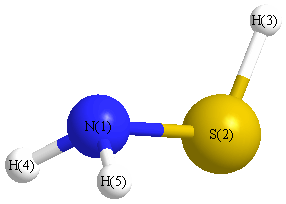Jump to
S1C2
Energy calculated at QCISD(T)/aug-cc-pVDZ
| | hartrees |
|---|
| Energy at 0K | -454.088834 |
| Energy at 298.15K | -454.092539 |
| HF Energy | -453.713890 |
| Nuclear repulsion energy | 56.473377 |
The energy at 298.15K was derived from the energy at 0K
and an integrated heat capacity that used the calculated vibrational frequencies.
Vibrational Frequencies calculated at QCISD(T)/aug-cc-pVDZ
| Mode Number |
Symmetry |
Frequency
(cm-1) |
Scaled Frequency
(cm-1) |
IR Intensities
(km mol-1) |
Raman Act
(Å4/u) |
Dep P |
Dep U |
|---|
| 1 |
A' |
3465 |
3388 |
|
|
|
|
| 2 |
A' |
2664 |
2605 |
|
|
|
|
| 3 |
A' |
1605 |
1569 |
|
|
|
|
| 4 |
A' |
1025 |
1002 |
|
|
|
|
| 5 |
A' |
903 |
883 |
|
|
|
|
| 6 |
A' |
656 |
642 |
|
|
|
|
| 7 |
A" |
3563 |
3484 |
|
|
|
|
| 8 |
A" |
1131 |
1106 |
|
|
|
|
| 9 |
A" |
377 |
369 |
|
|
|
|
Unscaled Zero Point Vibrational Energy (zpe) 7694.6 cm
-1
Scaled (by 0.9778) Zero Point Vibrational Energy (zpe) 7523.8 cm
-1
See section
III.C.1 List or set vibrational scaling factors
to change the scale factors used here.
See section
III.C.2
Calculate a vibrational scaling factor for a given set of molecules
to determine the least squares best scaling factor.
Geometric Data calculated at QCISD(T)/aug-cc-pVDZ
Point Group is Cs
Cartesians (Å)
| Atom |
x (Å) |
y (Å) |
z (Å) |
|---|
| N1 |
0.012 |
1.142 |
0.000 |
| S2 |
0.012 |
-0.633 |
0.000 |
| H3 |
-1.339 |
-0.767 |
0.000 |
| H4 |
0.535 |
1.451 |
0.823 |
| H5 |
0.535 |
1.451 |
-0.823 |
Atom - Atom Distances (Å)
| |
N1 |
S2 |
H3 |
H4 |
H5 |
| N1 | | 1.7755 | 2.3389 | 1.0233 | 1.0233 |
S2 | 1.7755 | | 1.3573 | 2.3011 | 2.3011 | H3 | 2.3389 | 1.3573 | | 3.0184 | 3.0184 | H4 | 1.0233 | 2.3011 | 3.0184 | | 1.6465 | H5 | 1.0233 | 2.3011 | 3.0184 | 1.6465 | |
 More geometry information
More geometry information
Calculated Bond Angles
| atom1 |
atom2 |
atom3 |
angle |
|
atom1 |
atom2 |
atom3 |
angle |
| N1 |
S2 |
H3 |
95.667 |
|
S2 |
N1 |
H4 |
107.550 |
| S2 |
N1 |
H5 |
107.550 |
|
H4 |
N1 |
H5 |
107.122 |
Electronic energy levels
Charges, Dipole, Quadrupole and Polarizability
Jump to
S1C1
Energy calculated at QCISD(T)/aug-cc-pVDZ
| | hartrees |
|---|
| Energy at 0K | -454.087842 |
| Energy at 298.15K | -454.091609 |
| HF Energy | -453.713808 |
| Nuclear repulsion energy | 56.638971 |
The energy at 298.15K was derived from the energy at 0K
and an integrated heat capacity that used the calculated vibrational frequencies.
Vibrational Frequencies calculated at QCISD(T)/aug-cc-pVDZ
| Mode Number |
Symmetry |
Frequency
(cm-1) |
Scaled Frequency
(cm-1) |
IR Intensities
(km mol-1) |
Raman Act
(Å4/u) |
Dep P |
Dep U |
|---|
| 1 |
A' |
3470 |
3393 |
|
|
|
|
| 2 |
A' |
2592 |
2535 |
|
|
|
|
| 3 |
A' |
1592 |
1557 |
|
|
|
|
| 4 |
A' |
1007 |
984 |
|
|
|
|
| 5 |
A' |
877 |
858 |
|
|
|
|
| 6 |
A' |
639 |
625 |
|
|
|
|
| 7 |
A" |
3577 |
3497 |
|
|
|
|
| 8 |
A" |
1117 |
1092 |
|
|
|
|
| 9 |
A" |
467 |
456 |
|
|
|
|
Unscaled Zero Point Vibrational Energy (zpe) 7668.4 cm
-1
Scaled (by 0.9778) Zero Point Vibrational Energy (zpe) 7498.1 cm
-1
See section
III.C.1 List or set vibrational scaling factors
to change the scale factors used here.
See section
III.C.2
Calculate a vibrational scaling factor for a given set of molecules
to determine the least squares best scaling factor.
Geometric Data calculated at QCISD(T)/aug-cc-pVDZ
Point Group is Cs
Electronic energy levels
Charges, Dipole, Quadrupole and Polarizability
